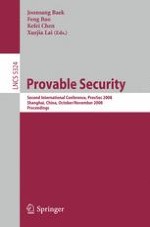2008 | Buch
Provable Security
Second International Conference, ProvSec 2008, Shanghai, China, October 30 - November 1, 2008. Proceedings
herausgegeben von: Joonsang Baek, Feng Bao, Kefei Chen, Xuejia Lai
Verlag: Springer Berlin Heidelberg
Buchreihe : Lecture Notes in Computer Science
